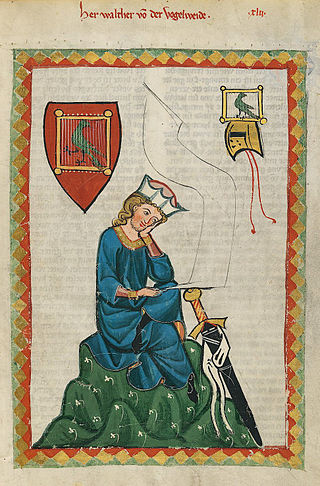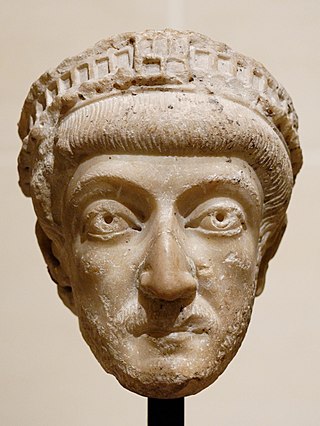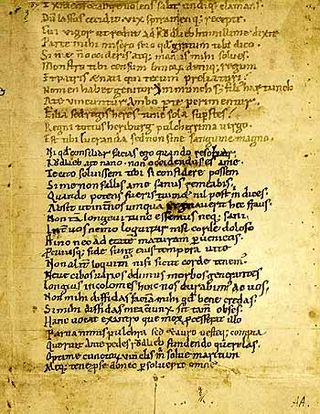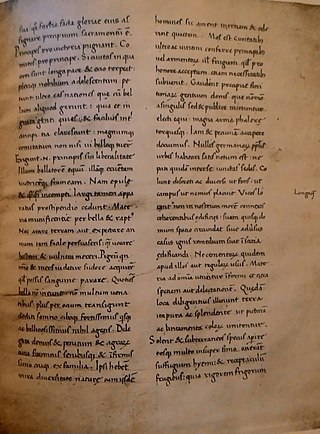Related Research Articles

The Vulgate, sometimes referred to as the Latin Vulgate, is a late-4th-century Latin translation of the Bible.
Diogenes Laërtius was a biographer of the Greek philosophers. Little is definitively known about his life, but his surviving Lives and Opinions of Eminent Philosophers is a principal source for the history of ancient Greek philosophy. His reputation is controversial among scholars because he often repeats information from his sources without critically evaluating it. He also frequently focuses on trivial or insignificant details of his subjects' lives while ignoring important details of their philosophical teachings and he sometimes fails to distinguish between earlier and later teachings of specific philosophical schools. However, unlike many other ancient secondary sources, Diogenes Laërtius generally reports philosophical teachings without attempting to reinterpret or expand on them, which means his accounts are often closer to the primary sources. Due to the loss of so many of the primary sources on which Diogenes relied, his work has become the foremost surviving source on the history of Greek philosophy.

Silvanus was a Roman tutelary deity of woods and uncultivated lands. As protector of the forest, he especially presided over plantations and delighted in trees growing wild. He is also described as a god watching over the fields and husbandmen, protecting in particular the boundaries of fields. The similarly named Etruscan deity Selvans may be a borrowing of Silvanus, or not even related in origin.

The Nibelungenlied, translated as The Song of the Nibelungs, is an epic poem written around 1200 in Middle High German. Its anonymous poet was likely from the region of Passau. The Nibelungenlied is based on an oral tradition of Germanic heroic legend that has some of its origin in historic events and individuals of the 5th and 6th centuries and that spread throughout almost all of Germanic-speaking Europe. Scandinavian parallels to the German poem are found especially in the heroic lays of the Poetic Edda and in the Völsunga saga.

Friedrich Carl von Savigny was a German jurist and historian.

Walther von der Vogelweide was a Minnesänger who composed and performed love-songs and political songs ("Sprüche") in Middle High German. Walther has been described as the greatest German lyrical poet before Goethe; his hundred or so love-songs are widely regarded as the pinnacle of Minnesang, the medieval German love lyric, and his innovations breathed new life into the tradition of courtly love. He was also the first political poet to write in German, with a considerable body of encomium, satire, invective, and moralising.

Gaius Julius Phaedrus, or Phaeder was a 1st-century AD Roman fabulist and the first versifier of a collection of Aesop's fables into Latin. Nothing is recorded of his life except for what can be inferred from his poems, and there was little mention of his work during late antiquity. It was not until the discovery of a few imperfect manuscripts during and following the Renaissance that his importance emerged, both as an author and in the transmission of the fables.

The Codex Theodosianus was a compilation of the laws of the Roman Empire under the Christian emperors since 312. A commission was established by Emperor Theodosius II and his co-emperor Valentinian III on 26 March 429 and the compilation was published by a constitution of 15 February 438. It went into force in the eastern and western parts of the empire on 1 January 439. The original text of the codex is also found in the Breviary of Alaric, promulgated on 2 February 506.

Gromatici or agrimensores was the name for land surveyors amongst the ancient Romans. The "gromatic writers" were technical writers who codified their techniques of surveying, most of whose preserved writings are found in the Corpus Agrimensorum Romanorum.

The Corpus Agrimensorum Romanorum is a Roman book on land surveying which collects works by Siculus Flaccus, Frontinus, Agennius Urbicus, Hyginus Gromaticus and other writers, known as the Gromatici or Agrimensores. The work is preserved in various manuscripts, of which the oldest is the 6th or 7th-century Codex Arcerianus.

Ruodlieb is a fragmentary romance in Latin verse written by an unknown southern German poet who flourished about 1030. He was almost certainly a monk of the Bavarian Tegernsee Abbey.
Hyginus, usually distinguished as Hyginus Gromaticus, was a Latin writer on land-surveying, who flourished in the reign of Trajan. Fragments of a work on boundaries attributed to him are found in Corpus Agrimensorum Romanorum, a collection of works on land surveying compiled in Late Antiquity.
De Munitionibus Castrorum is a work by an unknown author. Due to this work formerly being attributed to Hyginus Gromaticus, its author is often called "Pseudo-Hyginus". This work is the most detailed surviving description of a Roman military camp and dates most probably from the late 1st to early 2nd century AD.
The Novellae Constitutiones, or Justinian's Novels, are now considered one of the four major units of Roman law initiated by Roman emperor Justinian I in the course of his long reign. The other three pieces are: the Codex Justinianus, the Digest, and the Institutes. Justinian's quaestor Tribonian was primarily responsible for compiling these last three. Together, the four parts are known as the Corpus Juris Civilis. Whereas the Code, Digest, and Institutes were designed by Justinian as coherent works, the Novels are diverse laws enacted after 534 that never were officially compiled during his reign.
Vegoia is a sibyl, prophet, or nymph within the Etruscan religious framework who is identified as the author of parts of their large and complex set of sacred books, detailing the religiously correct methods of founding cities and shrines, draining fields, formulating laws and ordinances, measuring space and dividing time; she initiated the Etruscan people to the arts, as originating the rules and rituals of land marking, and as presiding over the observance, respect, and preservation of boundaries. Vegoia also is known as Vecu, Vecui, and Vecuvia, as well as Vegoe; her name is also given as Begoe or Bigois.
Karl Friedrich Wilhelm Zangemeister was a German librarian and philologist.

The Codex Aesinas is a 15th-century composite manuscript. It was discovered by chance in 1902 at the former private estate of the Count Baldeschi Balleani family located in Jesi, in the province of Ancona, Italy. The manuscript is considered especially valuable because it contains the Opera Minora of the Roman historian Tacitus, including the Agricola and the Germania. Due to the inclusion of eight folia written in Carolingian minuscule script within the Agricola, the Tacitus portion of the Codex is generally regarded as a direct copy of the missing Codex Hersfeldensis (H), a 9th-century manuscript that contained a copy of the original Opera Minora by Tacitus. The Carolingian folia are thought to be originals taken from the lost codex. In 1994, the Baldeschi Balleani family sold the codex to the Biblioteca Nazionale Centrale di Roma where it is now known as the Codex Vittorio Emanuele 1631.
Marcus Junius Nipsus was a second-century Roman gromatic writer, who also dealt with various mathematical questions. His surviving writings are preserved in the Corpus Agrimensorum Romanorum, a compilation of Latin works on land surveying made in the 4th or 5th centuries AD.
References
- ↑ Smith, William Smith (1867). . In Smith, William (ed.). Dictionary of Greek and Roman Biography and Mythology . Vol. 1. Boston: Little, Brown and Company. p. 71.
- ↑ Editions: Friedrich Blume, Karl Lachmann, Adolf Friedrich Rudorff: Gromatici veteres. Die Schriften der römischen Feldmesser. Band 1, Georg Reimer, Berlin 1848, pp. 59–90; Carl Olaf Thulin: Corpus agrimensorum Romanorum. B. G. Teubner, Leipzig 1913, pp. 20–51.
- ↑ Editions: Friedrich Blume, Karl Lachmann, Adolf Friedrich Rudorff (ed.): Gromatici veteres. Die Schriften der römischen Feldmesser. Band 1, Georg Reimer, Berlin 1848, pp. 1–58; Carl Olaf Thulin (ed.): Corpus agrimensorum Romanorum. B. G. Teubner, Leipzig 1913, pp. 51–70.
- ↑ Manuscript in the Herzog August Bibliothek in Wolfenbüttel, Inv. Cod. Guelf. 36.23 Aug. 2° (Digitalisat).
- ↑ Okko Behrends, Monique Clavel-Lévêque et al. (ed.): Agennius Urbicus. Controverses sur les terres (= Corpus agrimensorum Romanorum. Band VI). Office des publications officielles des Communautés européennes, Luxembourg 2005, p. xv.
- ↑ CIL XIII, 1674; CIL XIII, 1675
- ↑ See James N. Carder: Art historical problems of a Roman land surveying manuscript: The codex Arcerianus A, Wolfenbüttel. Dissertation, University of Pittsburgh 1976, p. 125–130; Brian Campbell, The writings of the Roman land surveyors. Introduction, translation and commentary. Society for the Promotion of Roman Studies, London 2000, pp. xxxi-v; Okko Behrends, Monique Clavel-Lévêque et al. Agennius Urbicus. Controverses sur les terres (= Corpus agrimensorum Romanorum. Vol. VI). Office des publications officielles des Communautés européennes, Luxembourg 2005, p. xiii-xxii.
- ↑ Codex Palatinus latinus 1564: Online; Codex Guelferbytanus Gudianus latinus 105: Online.
- ↑ Carl Olaf Thulin, Corpus agrimensorum Romanorum. B. G. Teubner, Leipzig 1913, p. 51, critical apparatus.
- ↑ Not to be confused with Hyginus Gromaticus.
- ↑ Carl Olaf Thulin (ed.): Corpus agrimensorum Romanorum. B. G. Teubner, Leipzig 1913, p. 51, ll. 8–10.
- ↑ Karl Lachmann, "Ueber Frontinus, Balbus, Hyginus und Aggenus Urbicus." in Friedrich Blume, Karl Lachmann, Adolf Friedrich Rudorff (ed.): Gromatici veteres. Die Schriften der römischen Feldmesser. Vol. 2, Georg Reimer, Berlin 1852, pp. 97–142, at p. 104.
- ↑ Karl Lachmann, "Ueber Frontinus, Balbus, Hyginus und Aggenus Urbicus." in Friedrich Blume, Karl Lachmann, Adolf Friedrich Rudorff (ed.): Gromatici veteres. Die Schriften der römischen Feldmesser. Vol. 2, Georg Reimer, Berlin 1852, pp. 97–142, at p. 112.
- ↑ Friedrich Blume: Ueber die Handschriften und Ausgaben der Agrimensoren. in Friedrich Blume, Karl Lachmann, Adolf Friedrich Rudorff (ed.): Gromatici veteres. Die Schriften der römischen Feldmesser. Band 2, Georg Reimer, Berlin 1852, pp. 1–78, at p. 6.